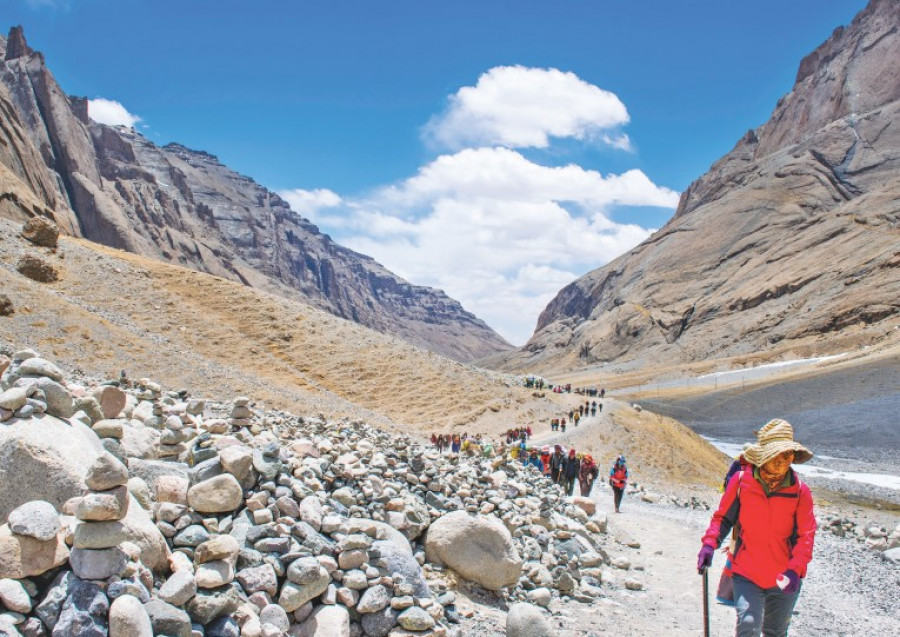
Thousands of Hindu pilgrims from India used to come to Nepalgunj in southwestern Nepal every year to fly to Simikot, from where they would enter Tibet for the Kailash Manasarovar Yatra.
The religious travellers would fill the hotels and restaurants, and keep travel agents, airlines, guides and porters busy. The annual pilgrimage season would be boom time for the tourism industry, and the government too would see increased revenue from taxes.
But the Yatra remains closed since 2020 because the route has been cut off, and Nepal is missing out on the millions of rupees the Indian pilgrims used to bring into the economy. It is uncertain if and when China will reopen the border.
On Wednesday, during a meeting of the Nepal-China Coordination Mechanism on Border Trade and Cooperation held in Lhasa, Nepali and Chinese officials agreed to fully reopen the Kerung border point for two-way trade and movement of people from April 1.
“But the meeting failed to raise the issue of opening Tibet for Kailash Manasarovar Yatra, one of the key revenue-earning activities,” said Basu Adhikari, managing director of Touch Kailash Travel and Treks.
“From Saturday, the Chinese will be allowed to cross the border into Nepal, but there is no reciprocity.”
According to travel trade entrepreneurs, in 2018, more than 20,000 Indian pilgrims travelled to the sacred mountain and lake in China via Nepal.
In 2019, the number rose sharply to nearly 30,000. Then Covid-19 came as a spoiler, and China closed the border in January 2020.
“We were expecting Tibet to open the border. Our counterparts in Tibet informed us that the Tibetan authorities would open the border, and accordingly, we started taking bookings from February,” said Adhikari.
“It’s uncertain now,” said Adhikari, who has received around 3,500 bookings from Indian pilgrims.
Travel trade entrepreneurs say they expect at least 15,000 Indian pilgrims this year.
Hotel entrepreneurs in Banke, who have spent a huge amount targeting Indian tourists, are not hopeful the business will rebound anytime soon.
The hotel association says more than Rs12 billion was injected into the hotels before the Covid pandemic as Indian arrivals started to swell.
Banke has two five-star and several four-star hotels. There are around 3,000 small and medium-sized hotels.
The investors who have pumped money into hotels are greatly worried.
“We are struggling to survive even though everything is normal now,” said Gorakh Thapa, proprietor of Hamro Dailekhi Thapa Hotel in Nepalgunj. Thapa pays Rs12,000 monthly to rent the house where he operates a small hotel.
“Nepalgunj used to be a hub for Indian tourists transiting to Tibet,” Thapa says. “It is no longer a lucrative business.”
Bharat Maitri Bus used to bring tourists from different parts of India. The service has stopped.
Faced with empty rooms, big hotels have started slashing prices.
“This has affected the small hotels,” said Bhim Lal Kandel, a central committee member of the Hotel Professional Federation Nepal.
“Nowadays, the cost of a room in big hotels has halved to Rs1,500 per night,” said Kandel.
The number of pilgrims visiting Kailash Manasarovar jumped in 2017 after Chief Minister Yogi Adityanath of the Indian state of Uttar Pradesh announced that his government would provide an IRs100,000 grant to pilgrims.
After the Chinese government closed the Tatopani border point north of Kathmandu due to damage by the 2015 earthquake, Indian travellers have been using the Nepalgunj-Humla route, the shortest way to reach Kailash Manasarovar.
There are five routes to Mt Kailash and Lake Manasarovar.
One is the disputed Lipulekh Pass. India has been opening the track of the link road for the Mansarovar Yatra from Dharchula to Lipulekh, known as the Kailash-Mansarovar Yatra Route.
Nathula in Sikkim, India is another. However, these routes are the longest and most expensive. It takes nearly three weeks to reach the holy place using these routes, and the trip is difficult too.
Moreover, only a few pilgrims travel on these routes as they need to get a special permit from the Indian government.
Nepal offers three routes to Kailash Manasarovar through the Tatopani and Rasuwagadhi border points. After the Chinese government closed these border points, Nepalgunj became the key gateway.
The Nepalgunj-Simikot-Hilsa-Manasarovar route is the shortest, and the itinerary is affordable and easy. Travellers usually fly from Nepalgunj to Simikot by fixed-wing aircraft, and then take a helicopter to Hilsa on the border with Tibet, China.
As Nepalgunj has become a major gateway, more than a dozen luxury hotels have sprung up to cater to Indian visitors.
After crossing Karnali, pilgrims are taken by motor vehicle to China.
Due to the high altitude, pilgrims acclimatise for one to two days in Purang, also known as Taklakot, the first city in Tibet. Lake Manasarovar lies at an elevation of 4,556 metres.
The Kailash Mansarovar Yatra season lasts from May to September.
Entrepreneurs selling the Kailash Mansarovar Yatra say they will be ruined if the route is not reopened.
“We have to apply to the Tibet Tourism Bureau with the documents of the pilgrims 45 days before the beginning of the yatra,” said Adhikari. “We have not heard anything from Tibetan authorities.”
Prices for the 14-day package over the surface route start at IRs185,000 per person.
Travellers flying from Nepalgunj to Simikot and onward to Hilsa, and then journeying overland to Kailash Manasarovar pay IRs225,000 each.
A tour package involving flying from Kathmandu to Lhasa costs IRs320,000 for Indians and $4,000 for other tourists.












